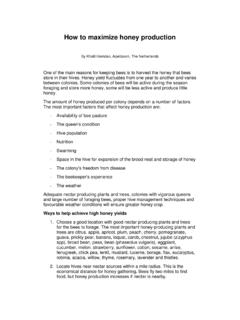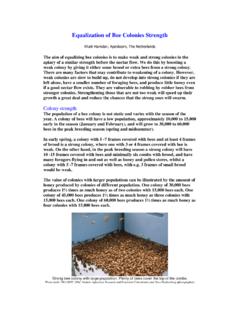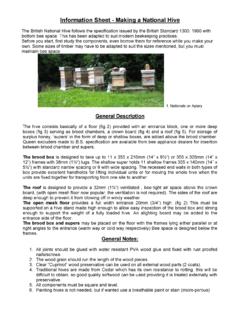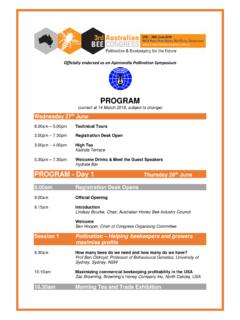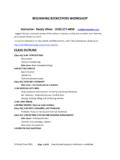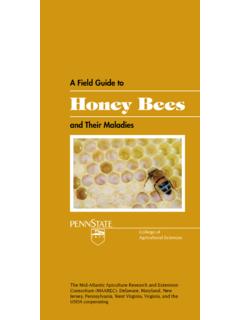Transcription of What is the Hopkins Method? - Country Rubes
1 How to raise a queen bee by the Hopkins method by Khalil Hamdan Apeldoorn The Netherlands what is the Hopkins Method? The Hopkins method is the removal of a frame with eggs or newly hatched larvae from a selected breeder queen. This frame is then given to a queenless cell builder colony. But it is not hung in the normal way; it is placed in a horizontal position above the brood nest. Realizing that they are queenless, the nurse bees will be stimulated to feed these larvae with an abundance of royal jelly and raise queens from them. The Hopkins method of raising queen bees is a simple method requiring no special equipment that can be employed easily by those who wish to raise queens for their own use.
2 It works pretty well and can be counted on to produce good quality queens just as good as those purchased from a commercial beekeeper. The Hopkins method can be used when a small number of queens are to be raised. Although the method allows the beekeeper to raise as many as 20 to 30 queens or more from one frame of brood, for a good quality queen it is best not to allow the bees to raise more than 20 at a time. The procedure Pre-Requisites: A breeder queen A cell builder colony A mating nuclei Getting young larvae from the breeder queen Choose a colony containing your best breeding queen, for example, one that lays well and produces a lot of brood. Remove a comb from the centre of the brood nest and replace it with an empty comb of light wax that the queen will lay eggs into.
3 Some prefer to use a shallow frame. Leave this there for 3-4 days or until it is filled with very small larvae, less than three days old. Remove it from the breeder colony, and brush off the bees. A comb filled with freshly hatched bee larvae, 4 days after the queen has laid eggs. A larva that has just started to lay with a slight curve in the bottom of the cell is the proper age larva for raising queens. Larva which fills cell is too old. Preparing the surface of Hopkins comb The best side of the comb is selected for the queen cells and rows of cells on the face of the comb are squashed flat. Three rows of cells out of four are destroyed using a matchstick or scored out to the midrib with a sharp warm knife.
4 Then two out of three cells in these remaining rows are destroyed to the midrib, leaving the third standing as a potential queen cell. If a small number of queens are needed, simply reduce the number of undamaged cells. This preparation leaves sufficient space between the remaining cells in which the bees can easily draw them out into queen cells and aids in cutting them out. If the brood comb is used without this preparation the queen cells will be built attached to each other and will be impossible to separate without damage. The comb is now ready to be placed into a specially prepared cell-building hive. A cell-builder hive is a strong colony without a queen. Preparing a cell-builder hive A colony will only build queen cells if it does not have a queen.
5 If a comb of eggs or young larvae were to be put into a normal queen-right colony with the intention of create queen cells, then this colony will not do so. Bees can be encouraged to make queens by deliberately making a colony queenless. In this condition the bees will attempt to raise a number of queen cells when given eggs or young larvae. That is what the cell-builder colony is for. Select a strong colony well supplied with honey and pollen, and many young bees. A single hive body colony can be used when only a few queens are to be raised. Temporarily remove the queen and the comb she is on with bees and place in a nucleus hive. The cell-builder hive is prepared overnight before the comb is put into the cell-builder.
6 It takes a few hours for the bees to decide they need a queen before you put the freshly prepared comb in. The prepared comb is placed flat over the middle of the brood nest of the cell-builder hive with the prepared side facing downwards, and raised up on small wooden blocks about 3 to 4 cm (1 inches) between the comb surface and the top bars of the frames below, so that the bees can draw queen cells down from the face of the comb. The comb is covered with a cloth to protect it from cold and an empty hive box or a shallow honey super is placed over it. All that is left to do is to put the lid on the hive If there is no honey flow, feed with sugar syrup during the cell building process, which takes about 4-5 days.
7 This will help stimulate the production of wax. The young nurse bees will draw down many queen cells on the horizontal frame, nurture larvae and complete the work. A larva destined to become a queen is fed lavish amounts of royal jelly throughout her larval development, which causes her to develop large ovaries and gives her the ability to lay eggs. Basically, royal jelly is a protein-rich substance secreted from glands located in the heads of young nurse worker bees. It is very nourishing allowing queen bee larvae to grow faster and larger as well as live for longer periods than other bees. A frame of newly hatched larvae from a breeder queen being placed horizontally over a cell-building hive. Photo by James Kilty Queen bee larvae floating in a pool of creamy white jelly in open queen cells.
8 Royal jelly is crucial in queen raising. Without this rich food, queen bees would not be able to develop properly. Frame with queen cells from Hopkins method Photo credit: Ohio Homestead Gardens & Apiaries Transferring the queen cells When the cells are sealed on day 13-14 of the queen raising process (or on the 10th day after the prepared comb is given to the cell builder), they should be cut out with a sharp knife and transferred to hives to be requeened or to mating nuclei. Handle ripe cells carefully. To avoid injury to the tender queen pupae the comb should never be shaken; gently brush the bees off. Mishandled cells result in deformed or dead queens. The queen cells should be transferred in a Styrofoam container with drilled holes of 19 mm ( in) diameter to hold each cell, or a small box (with a lid) filled with sawdust or wood shavings to minimise vibration.
9 Place them in an upright position in the box at all times. Keep queen cells at hive temperature until they are placed in queenless hives. It is essential to introduce the queen cells into your hives or nuclei immediately after removal. A queen cell can be introduced at any time after a laying queen has been removed, but for best acceptance it is better that the colony has been queenless for 1- 2 days. Destroy any emergency cells that have been started on the combs before introducing your queen cells. Insert the cell gently between the top bars of two frames in the centre of the hive in a vertical position. Care must be taken not to squash the cell as this may kill the young queen. A matured queen cell being inserted between two combs in the brood area in a colony to be requeened.
10 Photo by Cass Cohenour Mating hives are formed a day or two before the queen cells are due to emerge. These are mini nuclei contain 1- 4 small frames and about one or two cups of bees (1000- 2000), or larger 5 frames colonies. You can place the queen cells into the mating nuclei in the same manner as described above. Leave one cell in the cell builder to replace the queen or reunite the original queen back with her brood and bees. Hints on raising the queen bee Successful raising of new queen bees requires suitable conditions. You can raise good-quality queens by following the basic principles outlined here. Queens should be raised from the best colonies you have. Select a breeder queen of outstanding characteristic to breed from.
